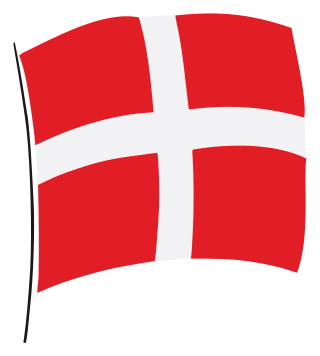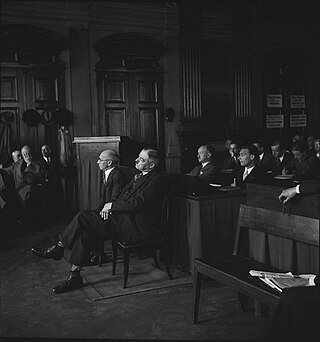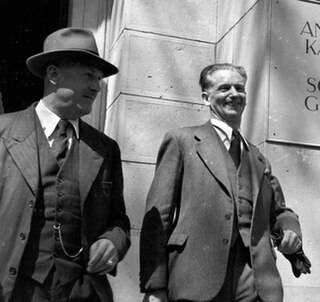Foundation
The NBS had its roots in the 1938 foundation of the Bund Treuer Eidgenossen Nationalsozialistischer Weltanschauung [ de ] by Rolf Henne after the more moderate Robert Tobler had removed Henne from the leadership of the National Front. [2] In 1940, the Bund absorbed a number of tiny Nazi-supporting organisations to become the NBS under Henne and Dr. Max Leo Keller. Other groups absorbed included the Eidgenössische Soziale Arbeiterpartei [ de ] and elements of the National Front. The new group also officially bore the French-language name Mouvement Nationale Suisse as an appeal to Francophone Swiss. [3] Keller had worked with Heinrich Himmler and brought with him Andreas von Sprecher, whom the SS had trained, to run the new group's propaganda department. [2]
Keller, Jakob Schaffner and Ernst Hofmann, as representatives of the NBS, received an audience with the Swiss President Marcel Pilet-Golaz (in office throughout 1940) in which they demanded much closer relations with Nazi Germany, leading to eventual incorporation. [2] This was followed by a Munich conference in October 1940 to which the Director of the Reich Security Main Office, Reinhard Heydrich and the Swiss doctor and SS-member Franz Riedweg invited the leaders of the NBS and of other Swiss groups in order to increase cohesion. [2] Ultimately the meeting strengthened the hand of the NBS, as the remnants of the Bund Treuer Eidgenossen Nationalsozialistischer Weltanschauung as well as the Eidgenössische Soziale Arbeiter-Partei and Ernst Leonhardt's Nationalsozialistische Schweizerische Arbeitspartei agreed to be absorbed into the movement. [2]
Despite this strengthening the National Movement did not last long, as the Swiss Federal Council feared that annexation by Germany was just around the corner. [2] In a series of moves against the most extreme groups, the NBS was closed down on 19 November 1940, by which time it had 160 cells and around 4,000 members. [2] The group continued to work underground for a time before a police crackdown which led to most of the leadership fleeing to Germany. [2] Whilst in Germany Keller set up the Bund der Schweizer Nationalsozialisten as an émigré movement, although its influence remained limited; eventually he returned to Switzerland in 1941. [2] Meanwhile, various NBS units continued underground activity secretly, mostly with help from the SS, until World War II ended in 1945. [2]

Ernst Julius Günther Röhm was a German military officer and a leading member of the Nazi Party. Initially a close friend and early ally of Adolf Hitler, Röhm was the co-founder and leader of the Sturmabteilung (SA), the Nazi Party's original paramilitary wing, which played a significant role in Adolf Hitler's rise to power. He served as chief of the SA from 1931 until his murder in 1934 during the Night of the Long Knives.

The Biographical Dictionary of the Extreme Right Since 1890 is a reference book by Philip Rees, on leading people in the various far right movements since 1890. It contains entries for what the author regards as "the 500 major figures on the radical right, extreme right, and revolutionary right from 1890 to the present" . It was published, as a 418-page hardcover, in New York by Simon & Schuster in 1990 (ISBN 0-13-089301-3).
The Austrian resistance launched in response to the rise of the fascists across Europe and, more specifically, to the Anschluss in 1938 and resulting occupation of Austria by Germany.

Franz Seldte was a German reactionary and politician who served as the Reich Minister for Labour in Nazi Germany. Prior to his ministry, Seldte was a founding leader of Der Stahlhelm World War I ex-servicemen's organisation from 1918 to 1934.

The National Front was a far-right party in Switzerland that flourished during the 1930s. At its peak the group had as many as 9,000 members, according to the Historical Dictionary of Switzerland, and "may have had a membership of 25,000 or so", according to the Simon Wiesenthal Center. The party was financed by the Reich Ministry of Propaganda. It became defunct in 1940 and was banned by the Swiss Federal Council in 1943.

Jakob Schaffner was a leading Swiss novelist who became a supporter of Nazism.

Karl Jäger was a German mid-ranking official in the SS of Nazi Germany and Einsatzkommando leader who perpetrated acts of genocide during the Holocaust.
Hans Oehler was a Swiss journalist and a sympathizer of Nazism.

The Berne Trial or Bern Trial was a famous court case in Bern, Switzerland which took place between 1933 and 1935. Two organisations, the Swiss Federation of Jewish Communities and the Bernese Jewish Community sued the far-right Swiss National Front for distributing anti-Jewish propaganda. The trial focussed on the Front's use of the fraudulent antisemitic text, The Protocols of the Elders of Zion. Ultimately decided in favour of the plaintiffs, the Front was ordered to pay a symbolic fine and court costs. However, the trial became significant both for the international coverage and also for the extensive evidence presented, demonstrating the falsehoods contained in The Protocols.

The government of Nazi Germany was a totalitarian dictatorship governed by Adolf Hitler and the Nazi Party according to the Führerprinzip. Nazi Germany was established in January 1933 with the appointment of Adolf Hitler as Chancellor of Germany, followed by suspension of basic rights with the Reichstag Fire Decree and the Enabling Act which gave Hitler's regime the power to pass and enforce laws without the involvement of the Reichstag or German president, and de facto ended with Germany's surrender in World War II on 8 May 1945 and de jure ended with the Berlin Declaration on 5 June 1945.
The far right in Switzerland was established in the course of the rise of fascism in Europe in the interwar period. It was a mostly marginal phenomenon in the Cold War period, excepting a surge of radical right-wing populism during the early 1970s, and it has again experienced growth alongside the right-wing Swiss People's Party since the 1990s.
Rolf Henne was a Swiss politician who supported a form of Nazism.

Robert Tobler was a Swiss far-right politician.
Eidgenössische Sammlung was one of several local names of a Swiss political party, founded in 1940 by Robert Tobler as a successor to the recently dissolved National Front.
Ernst Leonhardt was an American-born Swiss military figure and pro-Nazi Germany politician.

Franz Burri was a Swiss political figure who, from his base in Germany, became the leading disseminator of Nazi propaganda in the country. The media labeled him the "Helvetic Goebbels".

Franz-Josef Röder was a German politician of the CDU and from 1959 to 1979 Minister President of Saarland. He had been a member of the Nazi Party from 1933 to 1945.

The Freikorps Oberland was a voluntary paramilitary organization that, in the early years of the Weimar Republic, fought against communist and Polish insurgents. It was successful in the 1921 Battle of Annaberg and became the core of the Sturmabteilung (SA) in Bavaria while several members later turned against the Nazis.
Events in the year 1904 in Germany.
Max Leo Keller was a Swiss engineer and politician of the Fronts Movement.
This page is based on this
Wikipedia article Text is available under the
CC BY-SA 4.0 license; additional terms may apply.
Images, videos and audio are available under their respective licenses.











